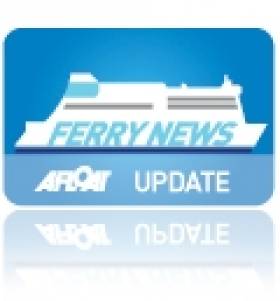Displaying items by tag: End of Dun LaoghaireHolyhead
Stena Line Confirms End of Historic Dun Laoghaire-Holyhead Ferry Service
#RouteClosure - Stena Line has confirmed today a consolidation of its services from Holyhead to Dublin Port. This will see the closure of the neighbouring historic ferry service from the Welsh port to Dun Laoghaire Harbour.
The company stated that it will be concentrating on expanding its existing ferry service at Dublin Port while at the same time confirming amid much speculation as previously reported on Afloat.ie that it is withdrawing its HSS Stena Explorer service from Dun Laoghaire Harbour.
There has been a ferry service on this Irish Sea route for 170 years (since 1835).
Stena Line ceased the HSS fast-ferry operated summer season sailings as scheduled last September. However as previously reported, in November the operator made a surprise announcment in the cancellation of sailings over the Christmas and early New Year season.
Ian Davies, Stena Line's Route Manager for Irish Sea South, said: "With two services operating approx. 10 miles apart we needed to make a decision in relation to what operation best serves the needs of our customers now and in the years ahead, and that operation is Dublin Port."
Stena Line has operated the HSS Stena Explorer into Dun Laoghaire since 1995 during which time the vessel has carried a mix of passengers, car and coach traffic. The Dun Laoghaire service was successful for several years following its introduction, carrying over 1.7 million passengers annually during its peak in 1998.
However, post the withdrawal of 'duty free' shopping, passenger and cars volumes declined dramatically and by 2014, less than 200,000 ferry passengers travelled through Dun Laoghaire Harbour. This represented a decline of over 90% in volume, making the route unsustainable.
During the same time period Stena Line has continued to make significant investment in larger better equipped vessels, and this, coupled with key improvements in road infrastructure and connectivity to Dublin, Belfast and further afield, has led to a significant uplift in both passenger and freight volumes through its evolving Dublin Port business.
Car and passenger volumes into Dublin Port overtook Dun Laoghaire as far back as 2008. Since then volumes through Dublin Port have continued to grow, as volumes through Dun Laoghaire have contracted thus providing Stena Line with a stark choice in relation to its future route network in the region.
Ian Davies added: "While we have enjoyed a very professional working relationship with Dun Laoghaire Harbour over many years, the economic realities of the current situation in relation to our business levels have left us with no choice but to close the service. Dublin continues to grow in importance, not only as the core freight port for Ireland but also as the key tourism gateway into Ireland."
"Ireland remains a strategically important region for us which is why Stena Line has invested over £250m across our Irish Sea business in the last five years alone. A number of economic indicators point to the continued recovery of the Irish and UK economies which has helped to stimulate renewed freight growth and returning tourism confidence in 2014. In 2014 we invested in a new Stena Line service to France from Rosslare and recently announced the arrival of the superferry Stena Superfast X into Dublin Port by late February."
Looking ahead, Stena Line is confident that this upward trend and to increasing its capacity on the Dublin Port service. The new vessel Superfast X with space for up to 1, 200 passengers and 2 km of vehicle lane capacity will operate a year round sailing schedule.























